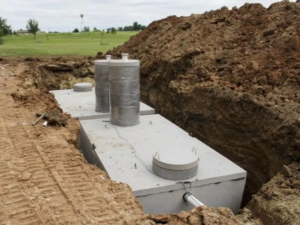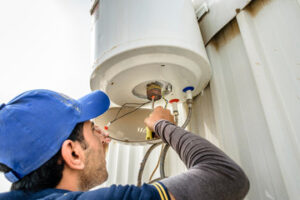Deer Park Plumbing is the system of pipes, fixtures and appliances that carry water and waste to and from a home or business. It’s crucial for everyday life and requires regular maintenance to keep it in good working condition.

A plumbing plan illustrates the pipes that bring freshwater in and take wastewater out. It uses standard, color-coded pipe symbols to identify different elements and creates accurate riser diagrams for review by plan examiners and homeowners alike.
When you think of your home’s plumbing system, the first thing that comes to mind is clean water flowing in and wastewater draining out. However, there is much more to the plumbing system than just this. It is a complex network that works behind the walls and under the floors to bring fresh water in and take waste water out. This system is essential to our everyday lives and should be maintained regularly to ensure it continues to function properly.
Understanding the basic functions of your plumbing system can help you avoid many common problems, such as leaks and overflowing toilets. You can also save money on your utility bills by learning how to conserve water. Plumbing is a complicated subject, but the basics are easy to understand. There are two main systems that make up your home’s plumbing: the water supply system and the drain-waste system. The water supply system brings freshwater in from the city water line or your private well. It distributes it to all the fixtures in your house, including sinks, bathtubs, showers, and appliances like washing machines and dishwashers. The water supply system operates under pressure, so it can deliver large quantities of water quickly and efficiently.
The drain-waste system carries used water away from your fixtures. Every fixture in your house has a drain that connects to the main pipes in your home’s plumbing system. These pipes are usually made of polyvinyl chloride (PVC) or acrylonitrile butadiene styrene (ABS). The drain-waste system uses gravity to move water, so it is slower than the water supply system.
It also contains traps to prevent sewage from entering your home. The system also has a venting system to regulate air pressure and allow sewer gases to escape. The venting system also keeps debris and other materials from siphoning into the drainage pipes, which could cause blockages.
If you notice a problem with your plumbing system, it is important to know which system it belongs to so you can call the right plumber for the job. It is often difficult to determine if a problem with your plumbing is in the water supply or drain-waste system, so it is important to know the difference.
It is a network of pipes.
A plumbing system is a network of pipes that delivers clean and fresh water into the house, takes wastewater away, and protects the home from dangerous gasses. It’s important to understand how your plumbing system works so that you can identify problems and call a plumber when necessary. This will save you money and help keep your home safe.
The main parts of a plumbing system are the supply lines, drainage lines, and vent pipes. The supply lines bring freshwater into your home from the municipal water supply or a private well. The pipes are usually made of copper or cross-linked polyethylene (PEX). The supply lines are under pressure, so they can deliver water to multiple fixtures at the same time without losing pressure. The drain lines take wastewater and sewage out of your home, either to the sewer line or to a septic tank. The vent pipes prevent odors and fumes from building up inside the home.
A faulty plumbing system can be dangerous for the health and safety of your family. It can lead to contaminated drinking water, damage your property, and harm the environment. Regular maintenance from professional plumbers can prevent these problems and ensure that your plumbing system is working properly.
Plumbing is a vital service that keeps homes and commercial buildings functional. It involves complex systems that are under constant use, so they require regular inspection and maintenance. Professional plumbers are trained to handle a wide range of plumbing jobs, from small repairs to major construction projects. They can also inspect the condition of your water-supply, drainage, and venting systems to determine if they are safe and effective.
While many people rely on plumbing systems to provide them with fresh and clean water, not everyone knows how these systems work. It’s crucial to understand how your plumbing system works so that it can be repaired quickly and efficiently when needed. Knowing the basics of plumbing can also help you avoid costly mistakes and emergencies in the future. With proper care, your plumbing system will last for years to come.
It is a system of fixtures.
Plumbing is the system of pipes and fixtures that supply water and remove wastewater in residential and commercial buildings. It is also the system that connects a building’s ventilation system to the drainage system. Plumbers are responsible for installing, repairing, and maintaining these systems. They use a variety of tools and techniques to perform their jobs. They may also need to work in tight spaces and confined areas. A skilled plumber can handle a wide range of problems, from minor repairs to complex installations.
The main job of a plumbing system is to deliver clean, safe water to all appliances and fixtures in a home or office. This includes both hot and cold water. The water comes from a public or private source, such as a city water line or a well. The system also delivers sewage waste to the sewer system or septic tank.
In addition to delivering water, the plumbing system helps protect the health and safety of the occupants by removing bacteria and other contaminants from the drinking water. Without a properly functioning plumbing system, people could become seriously ill from contaminated water.
There are two basic types of plumbing: piping and plumbing fixtures. Piping is a system of pipes that transports water, gas, and other materials. It can be used in a variety of applications, including heating and cooling, electrical power, and communication lines. Plumbing fixtures include toilets, sinks, faucets, and other accessories. These fixtures are connected to the piping system by means of valves and other fittings.
Plumbing requires regular maintenance to ensure that all components are working properly. A qualified plumber can inspect the entire plumbing system to ensure that there are no leaks or other problems. They can also recommend upgrades or other solutions to improve the efficiency of the plumbing system.
Many people have no idea how important their plumbing system is until something goes wrong. When you have a problem with your plumbing, it’s important to call in a professional as soon as possible to avoid further damage. Regular maintenance is also key to preventing expensive repairs down the road. For example, you should change your air filter regularly and check your water pressure.
It is a career.
Plumbing is one of the best careers for people who want to work with their hands. It’s a rewarding profession that can offer many benefits, from job stability to a sense of accomplishment.
Plumbers are a valuable part of our society. They help ensure that homes and businesses have functional water and waste systems, which are essential to health and safety. It’s no wonder why plumbers are in such high demand!
While many career paths require a bachelor’s degree, earning a trade certificate can provide you with the skills and knowledge you need to start your journey. In addition, many trade schools have apprenticeship programs that allow you to work while you learn on the job. This can save you time and money while you start your career.
Once you’ve completed your apprenticeship, you can take your journeyman exam and become a licensed plumber. Depending on your state’s requirements, you can then move into supervisory roles or even start your own business! With so many options, you’re sure to find a career in plumbing that’s right for you.
The need for skilled trade professionals has never been higher. And because the pay for plumbers is among the highest of any career, it’s a great choice for anyone looking to get started in a stable and rewarding field. Plus, plumbers can avoid the burden of student debt that often comes with going to college by choosing a trade school instead.



